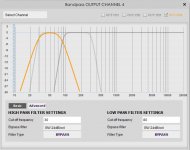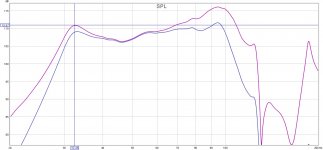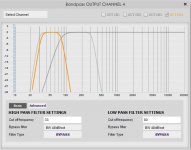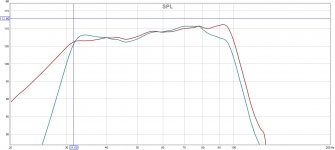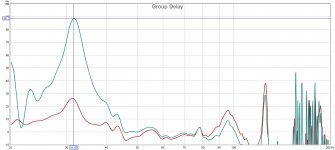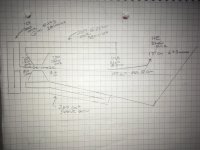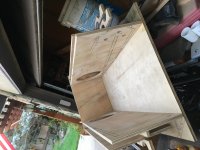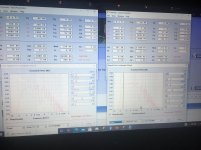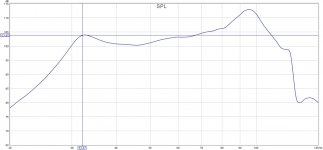
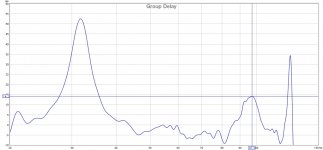
This is a beast!
The measurement is with my Umik 10 cm from the mouth and with 0.478 Volt from the JBL STAGE A6002 amp. The two 1 Ohm voice coils are coupled in series for a nominal 2 Ohm load.
The upper GD peak will be substantially flattened when this box is installed into a car cabin.
I need to EQ the midbass peak down 9 dB @ 90 Hz with a Q of 2.0 - 3.0 when used in my living room. It does add a nice solid and very physical bottom end to movies and music once properly EQed.
Everything from deadmau5 to Melody Gardot, Charlie Haden to Congi and Echo Roots to Hans Zimmer is reproduced with abundant energy and punch. It does have a slight character when used in a livingroom, but that is as expected due to being optimized for car audio usage.
That's a pretty high GD peak at 32 Hz, corresponding to the FR peak around that frequency. In car, that box will sound impressive, but not all that accurate, because cabin gain will likely boost that peak even more. In car audio terms, this is bordering on "one-note bass", but the peak might be low enough in frequency to make it less of an issue.
n car, that box will sound impressive, but not all that accurate
Have you heard a HROAR in a car? Or do you base this on some bass reflex or helmholtz based bandpass designs with similar spl response and GD?
his is bordering on "one-note bass"
I agree that a high Qts driver like this tends to "boom" a lot more then low Qts, high Bl drivers do. But "one-note-bass" is very far from the reality. The HROAR builds we have done and listened to have all impressed everyone who have heard them. Very much just because they are not "one note wonders" like most bassreflex boxes with a pronounced port peak tends to be.
I'm basing my opinion on the frequency and GD graphs that you've shared. I don't think sound particularly cares about what type of box is producing it - if there's a big GD peak at a particular frequency and there's a corresponding FR peak at that same frequency, then that means that you're going to have ringing at that frequency, i.e. one-note bass. It will be happening at 32 Hz though, so perhaps a lot less noticeable to the casual listener. This just isn't a box I'd build, that's all, because I'd aim for something more accurate for in-car use (which is probably why I'm using sealed enclosures and EQ for that purpose). YMMV.
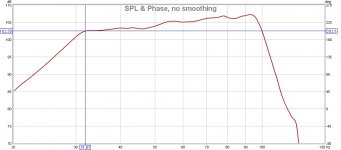
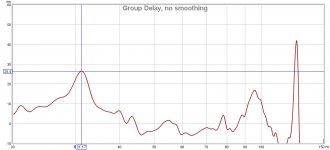
Here is a near field measurement of the HROAR12 as used with two points of EQ and XOVER (48dB/octave @ 90 Hz).
FR and GD is very oversimplified tools to judge the sound character of a loudspeaker. It is still mired down in an old Music=complex-of-simple-sinewaves dogma that is (or at least should be) long abandoned.
No bassreflex or Helmholtz based bandpass can sound like this HROAR, despite having the same FR, GD, Phase and distortion levels.
It is just like saying that a 1910 T-Ford and a 2020 Tesla model S is the same car due to the fact that both can travel at 50 km/h down a perfectly straight, flat and level road.
View attachment 879323
View attachment 879324
Here is a near field measurement of the HROAR12 as used with two points of EQ and XOVER (48dB/octave @ 90 Hz).
No bassreflex or Helmholtz based bandpass can sound like this HROAR, despite having the same FR, GD, Phase and distortion levels.
Agreed! I'd be curious to see what the response would look like with a 80hz -24db low pass filter, 30hz -24db high pass filter, and no EQ.
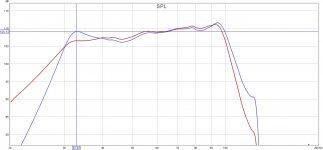
Here is my first setup with two points of EQ and 48 dB/octave 90 Hz LP compared to your suggested filter settings.
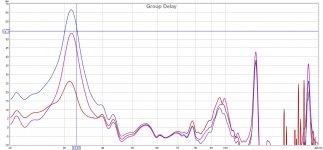
Here is the GD for the three different filter settings. The red line is my preferred EQ and 48 dB HP. The blue line is your filter setting.
This also displays why HP (subsonic) filtering is detrimental to the sound quality. The GD peak is even worse with a 30 Hz 24 dB HP filter then without.
I consider 26 ms @ 31 Hz rather good.
Last edited:
A funny but strange anecdote from my first round of evaluating this strange beast.
It is 22.50 here in Sweden right now and my wife is asleep and my son is down with some kind of flu in the room right next to our living room, so I am playing some jazz very quietly to not wake them up or disturb their sleep.
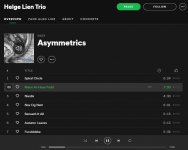
When sitting in my sofa I push my feet against our very heavy and solid wooden table and every time there is a bass transient with some low frequency content I feel it in the table and floor as a slight vibration.
This is with only a few mW of power. I cant really feel the driver move, but I can feel the vibration in the floor! It is a very strange sensation. I have tested several tracks and I even tried turning the main speakers of. This only seems to happen with uncompressed high quality recordings like this Helgen Lien Trio recording. It kind of ties into this ability to reproduce more complex and steep non-sinusoidal wave shapes that I find high order quarter wave enclosures has the ability to do.
This HROAR12 that is designed for plus 140 dB impressive bass of doom demos can really deliver with high end recordings! All it takes is a few points of EQ for the HROAR and more delay for the main speakers then one would believe (10 ms at the moment and both listening tests and measurements indicate I might need more), and I am surprised by the delicate handling of the short "dry" thuds of bass in the Helge Lien Trio recording. The bass "is just here" in a very natural and effortless manner, just complementing the main speakers with some added bottom end power and presences without drawing any attention to itself.
It is 22.50 here in Sweden right now and my wife is asleep and my son is down with some kind of flu in the room right next to our living room, so I am playing some jazz very quietly to not wake them up or disturb their sleep.

When sitting in my sofa I push my feet against our very heavy and solid wooden table and every time there is a bass transient with some low frequency content I feel it in the table and floor as a slight vibration.
This is with only a few mW of power. I cant really feel the driver move, but I can feel the vibration in the floor! It is a very strange sensation. I have tested several tracks and I even tried turning the main speakers of. This only seems to happen with uncompressed high quality recordings like this Helgen Lien Trio recording. It kind of ties into this ability to reproduce more complex and steep non-sinusoidal wave shapes that I find high order quarter wave enclosures has the ability to do.
This HROAR12 that is designed for plus 140 dB impressive bass of doom demos can really deliver with high end recordings! All it takes is a few points of EQ for the HROAR and more delay for the main speakers then one would believe (10 ms at the moment and both listening tests and measurements indicate I might need more), and I am surprised by the delicate handling of the short "dry" thuds of bass in the Helge Lien Trio recording. The bass "is just here" in a very natural and effortless manner, just complementing the main speakers with some added bottom end power and presences without drawing any attention to itself.
This is inspiring.
Im imagening a tapped horn with a front port, possibly tuned to 25isch and 65ish, with a few layers of felt infront of the port for a lower q. Driver offset 0.2-0.35 from the mouth like a voighthorn or transmissionline, maybe some damping in the mouth behind the driver.
I need to get good with hornresp.
Im imagening a tapped horn with a front port, possibly tuned to 25isch and 65ish, with a few layers of felt infront of the port for a lower q. Driver offset 0.2-0.35 from the mouth like a voighthorn or transmissionline, maybe some damping in the mouth behind the driver.
I need to get good with hornresp.
View attachment 878410
View attachment 878411
Another car audio bass driver HROAR build. It is very suitable for home theater and Hifi use as well - if the rather tactile, physical and powerful reproduction of bass is not a problem for neighbors, family or pets.
GAS has a new series of bass drivers, and the 12 inch drivers seams to be suitable for the HROAR design. GPX 300D1 – GAS Car Audio
The Qts might be a little to high for my liking and I would prefer a little more Bl, but my hands on experience indicates that it is a very nice and powerful driver.
We have a few hours of work left before we can measure and test it.
Our first impressions from just pushing the lid/top as tight as we could with our hands and body weight and powering this beast from a 10 watt 6 Dollar Ebay amp - is most promising. The radiator below the living room widows was rattling quite loudly and the bass was felt all throughout our house.
product dimensions w x h x d?
It seems I have stolen some of this energy and enthusiasm for 6/8th order qw pipes unknowingly. Though I have looked at the ROAR many times and built similar inverted chamber /tapped exit versions this is the first that more closely resembles the ROAR with an absorber chamber at the exit of the initial qw pipe segment. Thanks for the inspiration Circloman. it is very exciting and your enthusiasm is contagious.
The sim is kinda tricky, I probably should narrow that down better and share for critique and any ideas to make it an accurate representation
The sim is kinda tricky, I probably should narrow that down better and share for critique and any ideas to make it an accurate representation
Attachments
Sure, here’s random ideas as there’s nothing glued and screwed beyond s4. So L45 and also the L12 dont yet exist. If you can come up with anything that doesn’t exceed 15 mm in excursion using any L12 and L45 stuffed or open, mass loaded or expanding path, I’m Game to throw it in the mix ?
Along with accurate portrayal of the area between mouth tap entry (motorside) and exit of the 200cm2 237cm qw pipe(split path) s2... kinda sketchy as is...
Along with accurate portrayal of the area between mouth tap entry (motorside) and exit of the 200cm2 237cm qw pipe(split path) s2... kinda sketchy as is...
Attachments
Last edited:
product dimensions w x h x d?
900 x 655 x 422 mm. All plywood is 21 mm thick.
- Home
- Loudspeakers
- Subwoofers
- ROAR with Helmholtz front resonator
